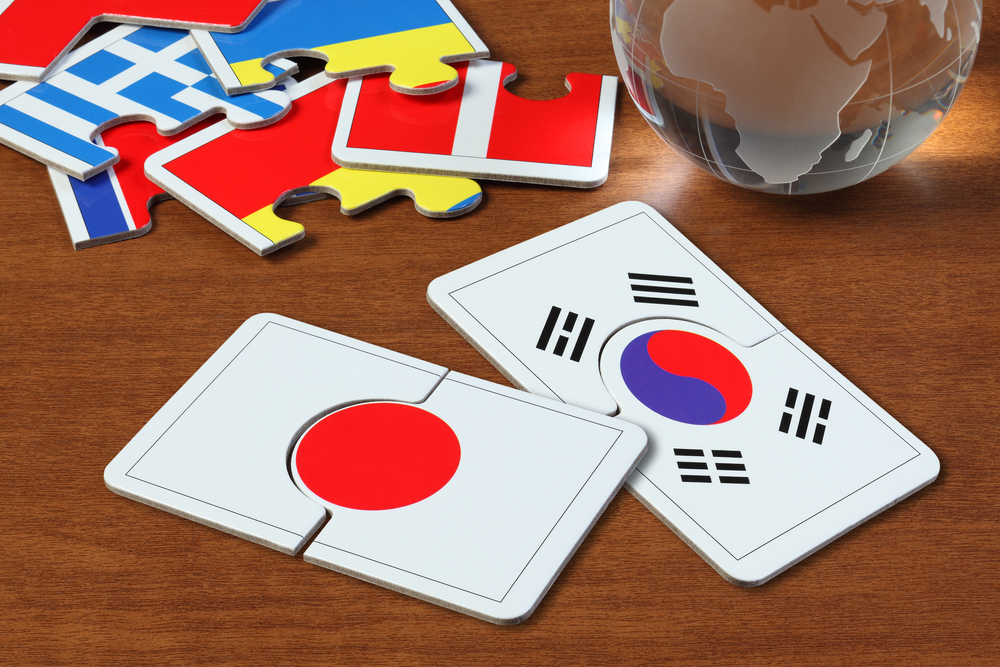- #Japan
- #South Korea

Key Takeaways:
・South Korea-Japan ties are at a crossroads. Historical and media perceptions of Japan’s new leader, Takaichi, could strain cooperation.
・Economic security convergence: Both nations increasingly view supply chains, semiconductors, and critical minerals as core to national security, offering grounds for alignment.
・Institutional cooperation opportunities: Proposals for a South Korea-Japan “economic 2+2” dialogue and deeper working-level communication could prevent past diplomatic rifts from reemerging.
Being a host is always tricky, more so when your guests include global superpowers bent on changing the world in their own ways, while your closest neighbours include nuclear-armed dictatorships and a former colonial power. That is the conundrum South Korean President Lee Jae Myung faces as he hosts the annual Asia-Pacific Economic Cooperation (APEC) forum this month in Gyeongju. The forum’s official theme is “Building a Sustainable Tomorrow: Connect, Innovate, Prosper.” This enables Seoul to set the agendas around digital, supply-chain resilience, and green transition issues, which, only a decade and a half ago, would have been well received by South Korea’s ally, the United States and quasi-ally, Japan. However, today South Korea finds itself sandwiched between an economically struggling China and an increasingly unpredictable United States, with only Japan and its soon-to-be-elected prime minister to garner support for crucial security and industrial policies.
All eyes are on the expected bilateral talks between the U.S. President Trump and Chinese President Xi (not to mention rumours of a possible U.S.-DPRK meeting). Given the United States and China’s importance to shaping regional strategic dynamics, such attention is understandable. However, too much focus threatens to eclipse the forum’s array of other important initiatives that Seoul is attempting to push forward. As a middle power situated close to mainland China and a manufacturing hub that doesn’t have any TSMC-shaped wild cards at its disposal, South Korea needs to occupy a position that can influence its larger partners in order to survive the economic and technological race. This is exactly the same position Japan is in.
While history-infused national confrontations have previously stumped South Korea-Japan relations since the normalisation of relations in 1965, an evolving geopolitical and geostrategic cooperation between the two countries has underlined the growing importance of their bilateral cooperation to achieving mutual strategic objectives. This short article examines the opportunities and challenges that lie ahead for these two countries.
Challenges
1) Media coverage and old wounds
Leadership transitions can reopen historical and political sensitivities that can hijack summit topics. It was only in 2018 that South Korea’s Moon Administration backed out of the agreement with Japan on the comfort women issue from 2015, leading to voices in Japan that South Korea could not be trusted on any promises.[1] This was not helped by then-prime minister Abe’s visit to Yasukuni Shrine in 2013. Managing tone and timing in Tokyo’s early decisions regarding such issues will be critical for Seoul’s ability to maintain domestic tolerance for cooperation. Korean media have framed Takaichi as a “female Abe” or “far-right”.[2] It is understandable that South Korean media look at her trail of right-wing remarks. However, we all know that media reports are not always the most accurate lens to rely on. Indeed, in Japan, a media photographer was recorded live on television quipping to “bring down her public approval ratings" at LDP headquarters. [3]
2) Keeping partnerships alive
Historical differences and media intentions aside, the news headlines often fail to capture the bigger picture, which is that Japan and South Korea share strategic imperatives to cooperate to stay competitive in the current global climate. It is important to keep in mind that while Takaichi holds a hawkish track record towards China, it is not as clear against South Korea.
Additionally, to say that Donald Trump’s second presidency has greatly rearranged the priorities of the ROK-Japan-U.S. security partnership is a gross understatement. In the economic field, he has hit both South Korea and Japan with punishing tariffs, as well as decreased the reliability of the U.S. military guarantee in East Asia. Moreover, his sympathies with autocratic leaders and unpredictability have led to both European and East Asian leaders scrambling to prop up the West’s alliance framework around that unstable hub. The stakes are high – the United States losing interest and willingness towards East Asian politics and military commitments will lead to China seeing an opportunity to further expand its influence in the region and even be tempted to take Taiwan by force.
Opportunities
1) Economic security:
Among the array of priorities shaping this year’s APEC agenda, economic security is a major part of it. For South Korea and Japan, the convergence on this front reflects a strategic recalibration: supply chains, advanced technologies, and critical minerals constitute their national security articulated in their strategic documents.[4] While this can be situated as a piece in the U.S.-China strategic competition, this nonetheless enables Seoul and Tokyo to leverage trilateral mechanisms with Washington to deepen bilateral implementation within APEC’s multilateral framework.[5]
Japan’s current domestic political environment reinforces this trajectory. Prime Minister apparent Sanae Takaichi, formerly economic security minister under Kishida, has championed tighter controls on strategically important technologies and targeted industrial investment. She is expected to maintain this emphasis while navigating internal pressures – from LDP factional dynamics to a Ministry of Finance cautious on fiscal expansion. This balancing act may favour cross-border industrial initiatives, particularly those aligned with economic security imperatives.
In the broader architecture of the region’s economic governance, Seoul and Tokyo are reframing their historically fraught relationship around these shared strategic interests. Their alignment in semiconductors, critical minerals, and dual-use technologies positions them to shape emerging norms within APEC, which has traditionally prioritised liberal trade but now faces calls to address economic resilience and technological sovereignty.
The September 2025 high-level economic security dialogue right after the summit between the two governments, underscores this momentum.[6] Embedded within the ROK-Japan-U.S. trilateral framework, their cooperation signals a maturing strategic partnership. Yet for this to endure, both sides must control domestic sensitivities around unresolved historical grievances and demonstrate through actions that economic security need not preclude public legitimacy or reconciliation.
2) Way forward
To utilise the opportunities and address the challenges above, there are ways to strengthen cooperation both on the working level as well as the leadership level. The working level communication between South Korea and Japan will inform each other’s intentions prior to any major foreign or industrial policy action, and hopefully avert a reenactment of the 2019 debacle of Japan excluding South Korea from the export fast-track “whitelist”. It will also open the way for bilateral ministerial-level exchanges, such as an economic 2+2 (bilateral meetings of both economic and foreign ministers) such as that established between Japan and the U.S., the U.K. and the EU in October 2025.[7] Once the leadership level dialogue is institutionalised, the working level discussions can be better organised and thus likely to endure. The bilateral economic 2+2 can also be used to share the information on how best to consolidate the alliance’s leverage to mitigate further damaging decisions coming from Washington.
Beyond official channels, fostering dialogue across policymakers, think tanks, industry leaders, and academics can help build consensus, clarify policy intentions, and pre-empt misinterpretations. These informal yet influential exchanges foster trust and innovation, especially in sensitive domains like supply chain governance, dual-use technologies, and critical mineral strategies. Moreover, both governments should prioritise substantive engagement over symbolic gestures. This means anchoring bilateral cooperation in tangible projects, joint R&D initiatives, coordinated investment screening mechanisms, and interoperable standards for emerging technologies. By focusing on deliverables that align with national interests and regional stability, Seoul and Tokyo can insulate their partnership from historical volatility and domestic political shifts.
Conclusion:
APEC Korea 2025 is set to test whether the new Japanese administration and the new South Korean administration can turn the region’s economic-security rhetoric into measurable resilience. The road can turn rocky if symbolism overwhelms policy or if macro constraints, such as the whims of the United States, choke ambitions. But if both sides keep their eyes on tangible projects such as supply-chain early-warning systems, mineral resource management, and semiconductor supply coordination, Gyeongju can mark the moment where South Korea and Japan shift from episodic rapprochement to structured economic-security partnership – with APEC as the amplifier rather than the stage for old quarrels.
[1] Sankei Shimbun, Ianfu zaidan no kaisan: yakusoku yaburu kuni to tsukiaenu (Dissolution of the Comfort Women Foundation: We Cannot Deal with a Country That Breaks Promises) November 22, 2018, Available at: https://www.sankei.com/article/20181122-2WKMSKAVJBPDBDX4V2HRITFERA/.
[2] Seo Jiyeong, If We Don't Stand Firm, Korea Gets Uppity" - Japanese Prime Minister Candidate 'Abe Girl' Makes Provocative Remarks, September 9, 2025, Asia Business Daily, available at: https://www.asiae.co.kr/article/2025090908131874694; JBpress, South Korea wary as “far-right” politician becomes LDP president: Criticism mounts over Takaichi’s past “get carried away” remark, thaw in Japan–ROK relations may be reversed. . October 11, 2025, available at: https://jbpress.ismedia.jp/articles/-/83621.
[3] The Japan Times, Jiji Press photographer reprimanded for improper remarks at LDP, October 9th 2025, available at: https://www.japantimes.co.jp/news/2025/10/09/japan/politics/jiji-photographer-inappropriate-remarks-on-takaichi.
[4] Cabinet Secretariat, Government of Japan. 2022. National Security Strategy of Japan. December 16. Available at: nss-e.pdf; The Government of the Republic of Korea, 2022, Strategy for a Free, Peaceful and Prosperous Indo-Pacific Region, available at: https://www.mofa.go.kr/eng/wpge/m_26382/contents.do.
[5] Kyodo News, Japan, U.S., South Korea to boost supply chains for industrial minerals, June 27, 2024, available at: https://english.kyodonews.net/articles/-/48188.
[6] The Korea Times, Korea, Japan hold economic security dialogue, September 10, 2025, Available at: https://www.koreatimes.co.kr/foreignaffairs/others/20250910/korea-japan-hold-economic-security-dialogue.
[7] The Japan News, Japan, U.S. to Hold 2+2 Meeting in U.S. in November
October 30, 2023, available at: https://japannews.yomiuri.co.jp/politics/politics-government/20231030-146659/; The Japan Times, Japan to hold regular economic security talks with U.K. under two-plus-two model, Nov 19, 2024, available at: https://www.japantimes.co.jp/news/2024/11/19/japan/japan-uk-economic-two-plus-two/: Nikkei Asia, Japan and EU to elevate ties, explore joint rare-earths procurement, July 17, 2025, available at: https://asia.nikkei.com/politics/international-relations/japan-and-eu-to-elevate-ties-explore-joint-rare-earths-procurement
